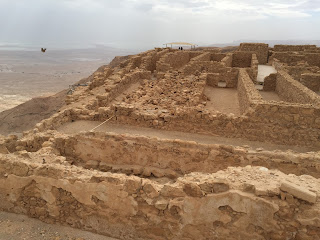Q
is for Qumran
Qumran was
established during the Hellenistic Period c.134-104BC and remained inhabited up
until c.68BC, multi-level structures, reservoirs, pottery kilns and houses have
been excavated in this era. It was during the Hellenistic Period that the
Essenes Jewish sect settled here, isolating themselves from big city life and
living as a communal monastery-like community. The sect is thought to have
eaten communal meals, studied sacred scriptures for most of the night, taken a
daily ritual bath, practice celibacy and they had their own calendar. From
information found in the Dead Sea Scrolls scholars have managed to get a clear
picture of the community’s way of life and beliefs. It is thought that about
200 people once lived here. In later periods of history there were Arab
settlements here and during the Bar Kokhba Revolution the rebels may have taken
refuge here.
In 1947
local Bedouins discovered a clay jar containing 7 scrolls in a cave about 1.5km
from Qumran. One of the most interesting scrolls describes the War between the Sons of Darkness and Light before the start of the Messianic Age. The ancient scrolls were sold to antique dealers and after
changing hands several times they reached scholars who could accurately
evaluate the age and value of the parchments. Further exploration uncovered a
total of 972 texts including the oldest known existing copy of the Old
Testament. The texts are written in Hebrew, Aramaic, Greek and Nabataen. The
scrolls are believed to have belonged to the Essenes sect. Some of the scrolls
describe the tenants of the sect and their particular slant on Judaism. In all
there were 12 caves where scrolls and fragments of parchment were found.
10 miles
south of Jericho, Qumran was on a “dead-end street” and provided a perfect
location for the isolationist sect of the Essenes to live.
A Long room
for dining was discovered and in the next room over, more than 1000 complete
vessels were found including 708 cups, 210 plates and 108 salad bowls.
All of these were serving vessels as they were never fired.
They have
uncovered aqueducts, cisterns, reservoirs, a tower, scriptorium, kitchen,
assembly hall, pantry, pottery workshop, kiln and cattle pen.
This is
definitely a place to visit when in Israel. If you want to see some of the scrolls, you can go to the Israel Museum (highlighted in a previous A to Z post).
I took lots of pictures so enjoy!
I took lots of pictures so enjoy!
 |
| View of the Dead Sea from the top |
 |
| see the caves?? |




















Whenever I read about scrolls, I wonder how many other, still buried, scrolls are out there. Hundreds? Thousands? Where will the next one be found?
ReplyDelete